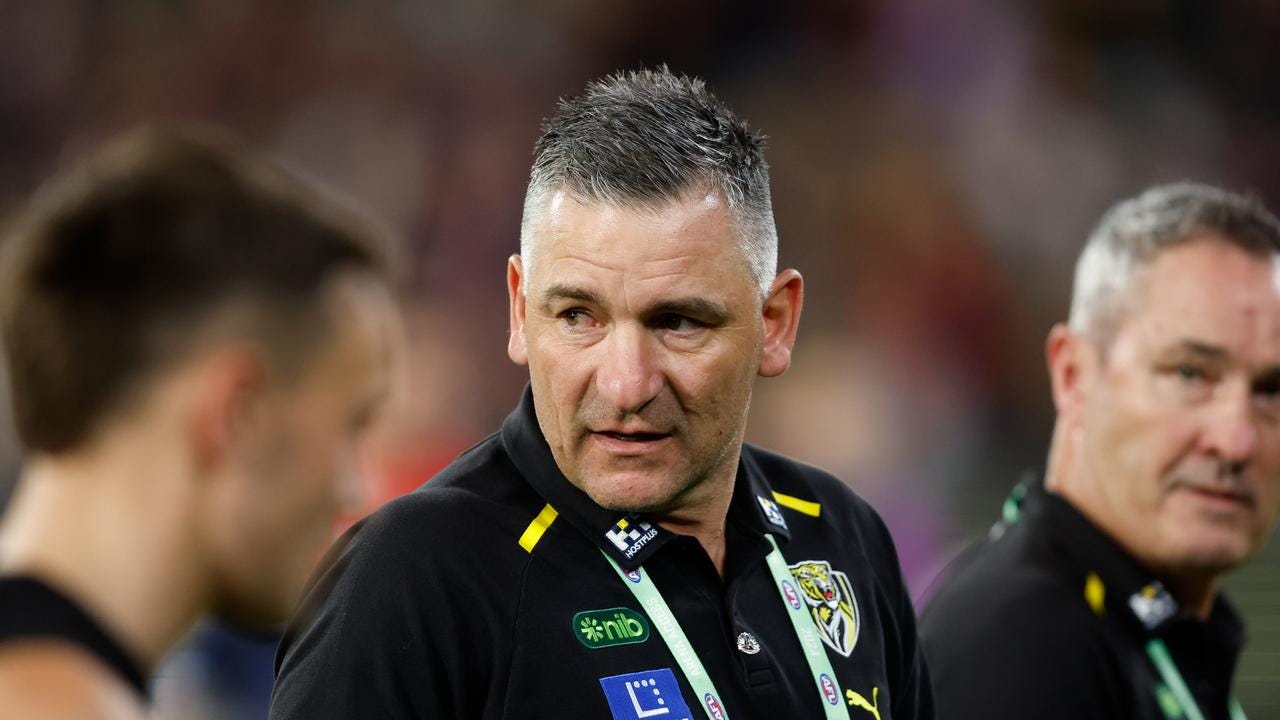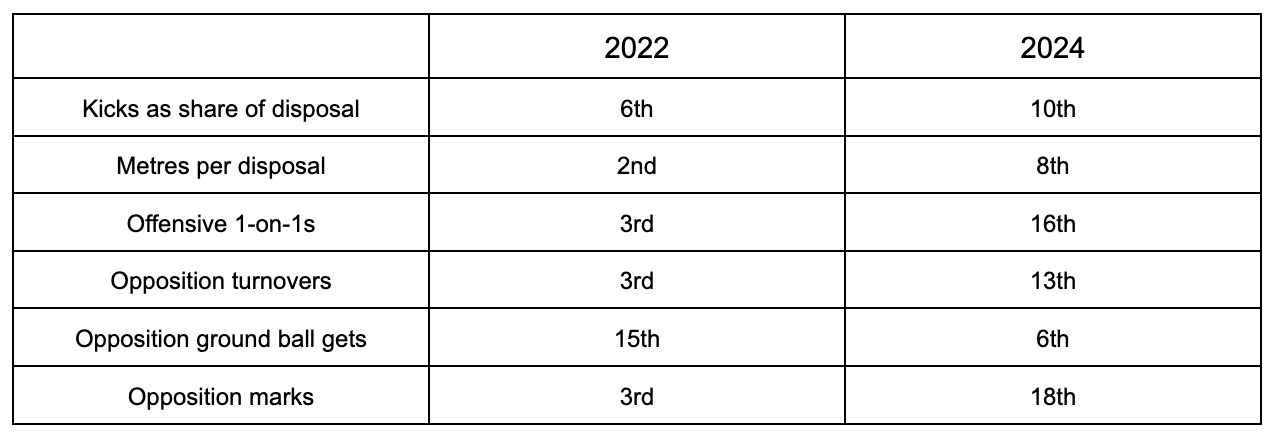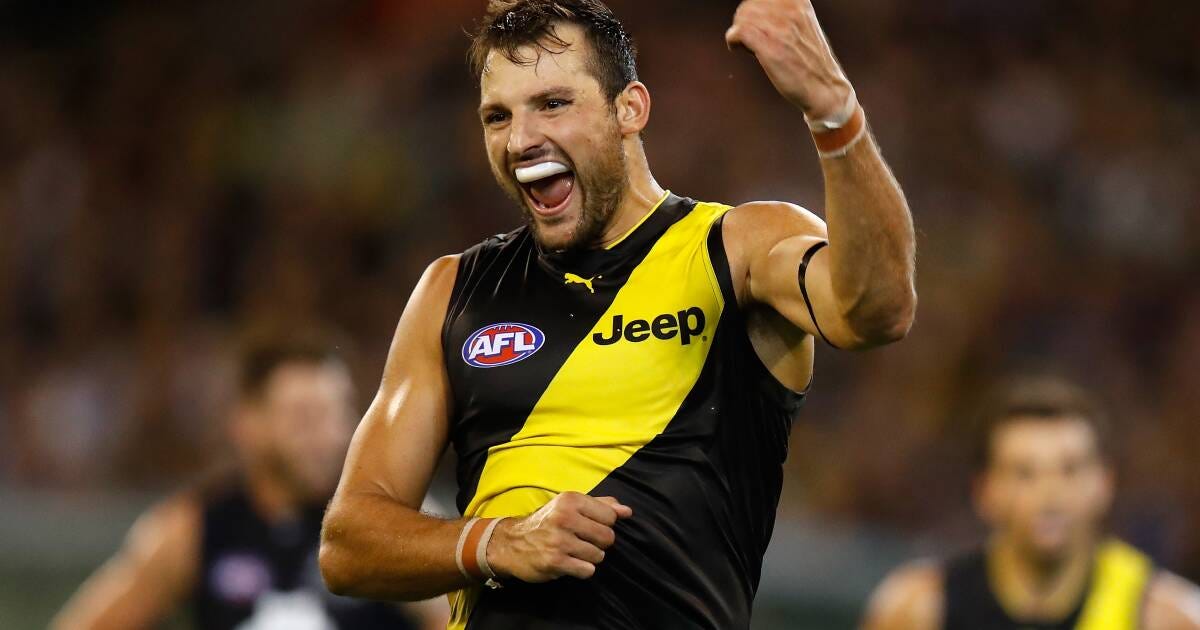2025 AFL Season Previews: Richmond
Just stick some gaffer tape over the score display.
Going to Punt Road (it’s very schmick these days) for preview #14.
2024 ladder position: 18th (2 wins, 21 losses)
2024 best-and-fairest: Daniel Rioli
Senior coach: Adem Yze
Story of the season
The page was definitively turned on the dynasty era, as Richmond won only two games for the whole season amidst a shocking – at times almost comical – injury crisis. The Tigers had the dubious honour of most games missed due to injury in the aggregate and most games missed due to injury for best-22 players. Five players ruptured their ACLs, Tom Lynch suffered a season-ending hamstring injury in Round 4, and there were plenty of other twangs and knocks besides. The Tigers had to dig deeper than any other club: 42 players on their list got a game. It made them frequently uncompetitive and hampered the implementation of second-year coach Adem Yze’s preferred game plan (still beat the bloody Crows though, didn’t they?). The end of the season brought a mass exodus which one suspects was somewhere between grudging and enthusiastically welcomed by the club’s recruiters: ten players, including Dustin Martin and Shai Bolton, bid goodbye to Punt Road. In their place came eight new draftees, including seven top-30 picks. The earth has been scorched – but not salted. It will yield again.
Summary of game style
As ever, it can be difficult to discern between intentional systemic changes and the effects of becoming a worse team. But, beyond the significant turnover in personnel, 2024 also revealed some clues in how the new Tigers regime wants to play footy. Out went the frenetic, turnover-oriented style so closely associated with Damien Hardwick, and in its place came a more patient, probing approach. Consider these stats:
No club slowed down how quickly they moved the ball from defensive 50 to attacking 50 as much as the Tigers. That conservatism, partly a deliberate stylistic choice and partly a means of protecting a depleted defence, meant they took fewer metres per disposal and generated fewer attacking one-on-ones. What was noticeable last season is how much Richmond (partly because of diminished forward personnel, partly because of aggressive opposition pressing) struggled to find outlets when exiting their defensive half. They lost possession more than a third of the time when kicking down the line from half-back. Defensively, a less aggressive – and functional – press diminished the Tigers’ ability to force opposition turnovers and force their opposition into a chaos-oriented style (with more ground balls than marks).
The (very) early evidence from Richmond’s pre-season games suggests that the Tigers will look to refine a similar approach: contest-first, with a focus on slow, controlled build-up from the back half to open up gaps in opposition mid-layer defensive zones, before cranking up the speed and carrying the ball forward of centre. It will be interesting to see how it plays out.
List changes
In:
Sam Lalor (2024 National Draft, Pick #1)
Josh Smillie (2024 National Draft, Pick #7)
Taj Hotton (2024 National Draft, Pick #12)
Jonty Faull (2024 National Draft, Pick #14)
Luke Trainor (2024 National Draft, Pick #21)
Harry Armstrong (2024 National Draft, Pick #23)
Thomas Sims (2024 National Draft, Pick #28)
Jasper Alger (2024 National Draft, Pick #58)
Out:
Shai Bolton (trade – Fremantle)
Daniel Rioli (trade – Gold Coast)
Liam Baker (trade – West Coast)
Jack Graham (free agent – West Coast)
Matthew Coulhard (delisted)
Noah Cumberland (delisted)
Dustin Martin (retired)
Dylan Grimes (retired)
Marlion Pickett (retired)
Sam Naismith (retired)
List profile
Number of top-10 draft picks: seven (T-7th)
Average age at Opening Round: 23.9 (17th)
Average number of games played: 53.9 (18th)
An exciting and also slightly terrifying off-season period saw 10 players, seven of whom were involved in Premierships (and one of whom was Dustin Martin), exit the stage. To Dusty you can add the names of stars and stalwarts like Dylan Grimes, Shai Bolton, Daniel Rioli, and Liam Baker. Independent footy newsletter pioneer and partial inspiration for this one, Ricky Mangidis, calculated that, in what must be a record, less than 77 percent of the total minutes played by Richmond players in 2024 will be “returning” this year. They will be replaced by a handful of players returning from injury and – more pertinently – eight new draftees.
For an expert opinion, I encourage you to read Michael Alvaro’s review of Richmond’s draft haul over at RookieMeCentral. For what it’s worth – and in full acknowledgement of the fact that evaluating draft intakes before, you know, any of them have actually played real games is one of the most futile endeavours in footy – I think Richmond’s approach was exactly the correct one. By drafting half of their future midfield, several important key position pieces, rolling the dice on some slightly speculative prospects (Taj Hotton) and enhancing their 2025 draft position, they’ve spread a lot of risk around. The only way I can see it really failing is if the entire draft is a bust, which would be a problem for more sides than just Richmond.
The significant list turnover will make the Tigers look very different in terms of personnel in 2025. In defence, the basic shape will involve Noah Balta (if/when he returns from being a naughty boy) and one of Jacob Blight or Ben Miller as the key backs, with Josh Gibcus and Luke Trainor as the pseudo-tall interceptors, Nick Vlastuin as the medium defender, and Nathan Broad and Jayden Short as half-backs. Clearly it’s some way off the spectacular defensive unit of the dynasty days. But – despite some uncertainty around the health of Gibcus, and Trainor’s form and susceptibility to concussion – it…. honestly doesn’t look that bad? Certainly not for the consensus wooden spooners.
Midfield looms as a larger issue. Jacob Hopper (Richmond must have half of all the AFL-listed Jacobs on their list), Tim Taranto and Jack Ross will assume the twin burdens of winning clearances and acting as personal security for the likes of Sam Lalor and Josh Smillie. It’s significantly harder to see who will take on the onus to create. Based on their underage performances, Lalor and Hotton have the skills, but it’s surely too much to ask for them to make major contributions in their debut years. If, as expected, Yze persists with a control-based ball movement scheme, then some onus will fall on the likes of Seth Campbell, Rhyan Mansell and possibly Maurice Rioli to drift into midfield zones to make themselves available as links in possession chains. Hugo Ralphsmith and Kamdyn McIntosh will start the season as the first-choice wings. It’s a workmanlike part of the ground.
There’s significant uncertainty about the shape of Richmond’s forward line because there’s significant uncertainty about the health of Tom Lynch and, even if he is playing, the extent to which his athleticism has diminished. The full-forward has only played eight games in the last two seasons and might never be the player he was. Harry Armstrong and Jonty Faull profile as exciting key position forwards (the former as more of mark and lead type, while the latter excels at crashing packs and bringing the ball to ground). Thomas Sims and Jasper Alger might need some time to develop their bodies. The likes of Mykelti Lefau, Jacob Bauer, and Jacob Koschitzke will probably all see lots of action (in the case of Lefau, once he returns from a ruptured ACL) as the next generation learn their craft.
In general though, it’s slightly hard to assess some of Richmond’s younger (but not first-year) prospects because they’ve been caught up in the transition between one era and regime with a highly distinctive style to a new system that’s still being bedded in. I would expect several players to show more as they get more used to Yze’s style.
Line rankings
Defence: Average
Midfield: Below Average
Forward: Below Average
Ruck: Above Average
The case for optimism
Despite the horrors to come over the next three or so years, most Richmond fans I’ve spoken to are maintaining a cheery sense of optimism because of the interaction of two strong forces: the perpetual glow of a recent dynasty, the best moments of which can be constantly replayed in high definition, and the unique excitement that comes with watching half-a-dozen exciting new draft picks develop in front of their eyes.
There are no expectations on Richmond in 2025 beyond pumping games into their young players and also getting them schooled in the ways of Oozeball (or should it be Camelball?). Anything beyond that, including the number of wins they accrue, is a pure bonus. And because of their decision to trade one of their thousands of 2024 first-round picks for North Melbourne’s 2025 first-rounder, there’s a decent chance that the Tigers will have the first two picks of this year’s draft. Not bad.
As bad as things will most likely be on the field in 2025, I’m not quite persuaded that Richmond will be Melbourne-under-Mark-Neeld bad. Despite the number and quality of players that have dropped off the list in the last two years, there’s still some established senior talent on the list. Lynch, Balta, Nankervis, Taranto, Hopper, Vlastuin, Broad isn’t winning a flag. But, especially if paired with a patient, control-first style, I’m not sure it’s getting smashed to smithereens every week. And if it is? Then loyal Tigers fans will have lots of room to stretch out at home games.
The case for pessimism
Richmond will lose lots of games. Many of them by large margins! It won’t be much fun for supporters, coaches or players. During their call of Richmond’s pre-season game against Collingwood last Wednesday, one of the Fox commentators mentioned that the Tigers could win as few as four to six games this season. I think this is quite an optimistic forecast! It’s a long season. They should win one (they’ll be playing West Coast and North Melbourne in consecutive rounds in May). But I certainly wouldn’t be shocked if the Tigers didn’t beat their total from 2024.
Part of the reason I think four to six wins is an optimistic forecast is because of the Richmond high performance team’s careful public communications – no doubt shaped by the experience of last season – when it comes to managing the returns of their convalescing players. That, combined with an emphasis on “establishing the game plan”, suggests a focus on getting through the first half of the year before improving and perhaps notching some wins as they approach the end. The corollary to that, of course, is that young players often struggle with the physical demands of a long season – so most of the benefits of having players return from injury could well be offset by the exciting draftees being worn down by attrition.
Losing environments are also difficult player and coach development environments. One of my many minor footy grievances is when people commend successful sides on their willingness to play young players. It’s much easier giving a young midfielder centre bounces when they’re surrounded by great players in a side that wins most of its games! Sides like Richmond face a significantly more complex problem: balancing the need to develop their young players with the need to win, or at least stay competitive in games to burnish supporter morale and ensure the coach retains some political capital. In the early stages of a rebuild, those goals are frequently at odds. Part of the reason North Melbourne plunged into an abyss they’re still struggling to climb out of is that they cut too deep, and exposed young players to the rigours of senior football without enough competent senior leaders around them. The Tigers have cut very deep. But they also had a significantly greater reserve of mature talent to cut.
A word on Yze. Last season told me almost nothing about his acumen as a coach, and I’m not sure this season will teach me much either. When I talk about a difficult development environment, I also mean for him. He will probably feel the temptation, at certain moments in the season, to try and pinch a win (or a near-win) by playing a few more senior players instead of the kids. Richmond appear to be the sort of stable and mature organisation that won’t overreact to successive seasons down the bottom of the ladder. But clubs can do silly things when times are tough, and there’s a reason not many coaches survive to see the end of a rebuild.
Enjoying this preview and think a Tigers-supporting friend might too? Share it with them!
Breakout player
I only nominate players who’ve actually debuted, which rules out all of Richmond’s exciting 2024 draftees. That leaves three obvious candidates: Jacob Blight, Jacob Bauer, and the lesser-spotted Josh Gibcus. Blight has been something of a revelation down back since being recruited in last year’s mid-season draft. Bauer, picked up at the corresponding stage of 2022, has shown promising flashes and, given the injury concerns around Tom Lynch and Mykelti Lefau, will get plenty of good minutes up forward. Josh Gibcus is the one, though. He’s shown enough in his 20 AFL games to make his talent as a pseudo-tall, intercepting key back clear. After severe injuries in back-to-back seasons, Richmond’s high performance team is taking it slow. Gibcus won’t feature for the first few rounds, but when he does, Tigers fans will hope he flourishes.
Most important player
Toby Nankervis is Richmond’s captain and one of only a handful of players still left from the dynasty days. His leadership will be important, but not as important as his health. He’s the only recognised ruck on the list and, with due respect to Samson Ryan, it’s not like he’s blocking the path of a talented young prospect. If Nankervis misses significant amounts of footy, the Tigers will become significantly less competitive, for minimal long-term benefit. Jayden Short, who appears to be the designated kicker from the defensive half, would also make the podium.
Biggest question to answer
The only question that really matters for Richmond’s medium-term future is how much the kids show. I’m not even convinced that it’ll be possible to draw any meaningful conclusions about Adem Yze’s coaching acumen. In most games, the Tigers will simply be battling to keep their heads above water.
What success looks like
Success for the Tigers in 2025 will be measured purely by the development shown by their young players. Not just the 2024 crop, either. The departure of so many senior players should give the likes of Josh Gibcus, Rhyan Mansell, Tom Brown and Tyler Sonsie a chance to show that they are long-term players for the club while also honing their own leadership credentials. Avoiding the embarrassment of not winning a single game would be nice, too.
In a nutshell
Year 1 of perhaps the most radical scorched earth rebuild in AFL history will yield few wins but provide Richmond fans with the satisfaction of watching a clutch of highly-touted youngsters play without expectations, with the promise of several more years’ worth of top-end draft picks to come. If they get too downbeat about things, they can always stick on a replay of the 2017, 2019 or 2020 Grand Finals.
Agree? Think I’m a fool who’s biased against Richmond? Share your thoughts in the comments.







